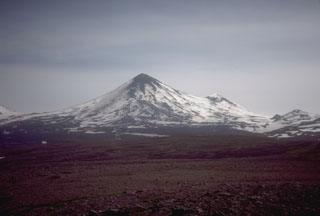Report on Pavlof (United States) — May 1976
Natural Science Event Bulletin, vol. 1, no. 8 (May 1976)
Managing Editor: David Squires.
Pavlof (United States) Ash emissions in mid-May
Please cite this report as:
Global Volcanism Program, 1976. Report on Pavlof (United States) (Squires, D., ed.). Natural Science Event Bulletin, 1:8. Smithsonian Institution. https://doi.org/10.5479/si.GVP.NSEB197605-312030
Pavlof
United States
55.417°N, 161.894°W; summit elev. 2493 m
All times are local (unless otherwise noted)
7 May, 1200: all flanks of volcano snow-covered. 14 May, 1500: dark ash visible on cone. 16 May, 2100: dark ash and steam emission visible. 20 May: upper 100 m of cone irregularly darkened, apparently from ash. Steam issuing from cone. At 2000, a thin layer of ash at the 3,000-m level was carried S for at least 25 km. At 2045, light grey material was ejected a few hundred meters. 21 May, 0900-0930: steaming. 31 May, 1200-1500: quiet. No longer possible to distinguish (at distance) between new ash darkening snow and dark bedrock exposed by melting snow.
Geological Summary. The most active volcano of the Aleutian arc, Pavlof is a Holocene stratovolcano that was constructed along a line of vents extending NE from the Emmons Lake caldera. Pavlof and Pavlof Sister to the NE form a dramatic pair of symmetrical, glacier-covered stratovolcanoes that overlook Pavlof and Volcano bays. Little Pavlof is a smaller cone on the SW flank of Pavlof volcano, near the rim of Emmons Lake caldera. Unlike Pavlof Sister, eruptions have frequently been reported from Pavlof, typically Strombolian to Vulcanian explosive eruptions from the summit vents and occasional lava flows. The active vents lie near the summit on the north and east sides. The largest recorded eruption took place in 1911, at the end of a 5-year-long eruptive episode, when a fissure opened on the N flank, ejecting large blocks and issuing lava flows.
Information Contacts: P. Sventek, USAF, Cold Bay.

